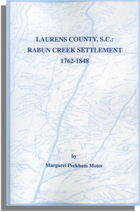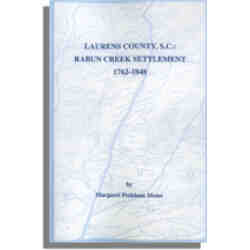The original settlement along Rabun Creek (situated about five miles west of the City of Laurens, Laurens County) is associated with migrants from Virginia, Maryland, and North Carolina (many of them Scots-Irish). Rabun Creek’s first recorded settler was a John Turk in December 1752; however, the settlement of the up-country in South Carolina grew slowly in the 1750s due to conflicts with the Cherokee Nation. Renewed settlement occurred after the 1755 Cherokee Treaty, but was short-lived. The Cherokee War brought turmoil to the frontier during 1760-1764. Resolution of the Cherokee conflict, restoration of order, and establishment of some governmental structure of the back country allowed rapid expansion to occur after 1765.
The area was now in transition from the earlier Indian traders and frontiersmen to yeoman planters. The new settlers were Quakers, Baptists, Irish, Scots, and English looking for new land in this section of the up-country. With the outbreak of the American Revolution, the Cherokee joined forces with Loyalists to harass the new arrivals. For example, James Lyndley’s fort, built after 1768, became a safe haven for Rabun Creek inhabitants during the Revolution. With the end of the Cherokee threat, the region stabilized; new Indian lands were open for settlement, and a number of Rabun Creek progeny would make their way to Georgia, Alabama, Tennessee, and Ohio in quest of Indian and bounty land now available there.
The work at hand, Laurens County, South Carolina: Rabun Creek Settlement, 1762-1848, contains abstracts of the South Carolina Journal Petitions for Land, South Carolina Colonial Surveys, and Memorials of Land Titles, with chains of title, marriage data, and many lost pieces of information that will assist researchers in this area of Laurens County, SC. These land deeds present new research aids to follow the out-migration of families—including many of the earliest land transactions, powers of attorney, and last will and testaments—as deeds of gift to family members are found. Ordinarily, Rabun Creek marriages went unrecorded and are difficult to locate, but they also show up in these deeds as dower rights and prior marriages. Children are also found when receiving deeds of gift consisting of lands or named Negroes from family members. Among published sources, Brent Holcomb’s works on the Petitions for Land from the South Carolina Council Journals and Sarah M. Nash’s Abstracts of Early Records of Laurens County, SC 1785-1800 were particularly helpful to the author.
Typically, each of the roughly 2,000 entries identifies each landowner, the date of the sale, name of previous owner, price of the transaction, names of adjacent landowner(s), date of survey, names of witnesses, and, as stated above, sometimes a number of family connections to the landowner. Complete with name and place indexes, this pioneering work identifies thousands of ancestors with connections to Rabun Creek prior to 1848.
Laurens County, South Carolina.: Rabun Creek Settlement, 1762- 1848 is similar in many respects to Laurens & Newberry Counties, S.D.: Saluda and Little River Settlements 1749-1775 by the author and her husband, Jesse Hogan Motes, which received the 1995 Excellence Award for Genealogical Methods and Sources from the National Genealogical Society.


